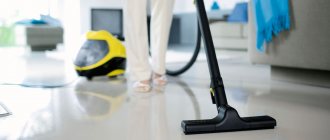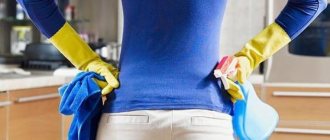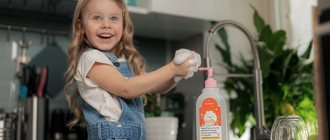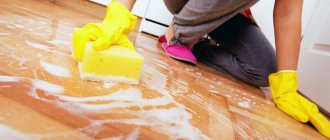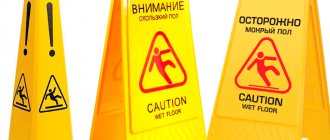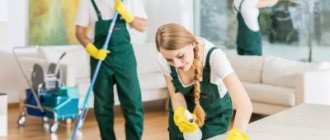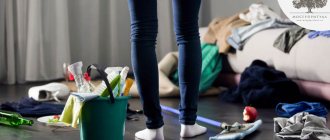Cleaning in a hospital is a constant process, since we are talking about a medical institution where the requirements for disinfection, asepsis and antiseptics are very high. According to sanitary and epidemiological standards, each hospital room should be cleaned using a certain technology using disinfectant solutions and cleaning equipment allocated individually for each room.
- Types of hospital cleaning
- Cleaning rooms in a hospital
- Cleaning corridors in a hospital
- Hospital cleaning solutions
Routine and general cleaning in a medical facility can only be carried out by specially trained and qualified personnel.
Types of hospital cleaning
There are several methods that are regularly used in medical institutions:
- physical (ultraviolet irradiation, steam, boiling method);
- mechanical (wet types of cleaning, regular washing of staff’s hands, repair work);
- chemical (soaking in disinfectant solutions with complete immersion of objects, use of bulk and spraying agents);
- combined (two or more methods are alternated by a medical professional).
Professional services
Routine cleaning in any establishment should be carried out by specially trained personnel. If there are no people on staff, or for some reason they cannot fulfill their duties, you can turn to specialists.
What is the price per meter and how to calculate the cost?
The cost of ongoing daily cleaning of the premises depends on the specifics of the work. If you have to pay about 20 rubles per square meter for maintenance cleaning in an apartment, then for owners of medical institutions the price will exceed 80 rubles per square meter.
The calculation is easy to do. It is enough to multiply the area of the room by the stated amount to get the final result. It is important to do this before concluding a contract. The full range of work and the cost of their services are discussed with the cleaners in advance.
Unscrupulous cleaners may increase the price due to the need to use disinfectants, although their use is mandatory in medical institutions. Therefore, initially the cost of such cleaning per square meter is higher than for private houses or apartments.
Where to find specialists?
To find specialists to perform routine cleaning, you can contact a cleaning company.
Firms providing such services have a fully staffed staff. They can provide services one-time or on an ongoing basis .
The advantage of choosing professional cleaners is that they have been trained and work with specialized equipment, tools and supplies. As a rule, employees are punctual and polite, perform a full range of work at a pre-agreed time
Cleaning rooms in a hospital
There are the following types of cleaning of hospital wards:
- current - 2 times a day;
- general - once a month.
Equipment used for cleaning must be marked: they write on it what rooms and types of cleaning it is intended for or are marked with the appropriate color. It must be used in accordance with its intended purpose and stored in a specially designated unit. In the same block there is usually a “decoding” of inventory color tags, if any.
Cleaning personnel are regularly trained to always be aware of the rules for carrying out sanitary measures and not to forget about the intricacies of their implementation. Rooms are cleaned wearing a robe, hat and gloves.
The algorithm for staff actions during routine daily cleaning of wards should look like this:
- a health worker warns patients about the upcoming cleaning;
- puts on a special gown and other protective equipment;
- examines the ward;
- prepares disinfectant solutions;
- wipes all horizontal surfaces in the room, as well as doors, furniture and appliances;
- cleans the sink;
- takes out the trash;
- mop the floor;
- ventilates the room for 15 minutes;
- carries out quartz treatment;
- disinfects, cleans and dries equipment.
It is customary to carry out general cleaning of the wards at least once a month. Unscheduled general cleaning is carried out in the event of an unfavorable epidemiological situation or in the event of positive tests from the laboratory for one or another pathogenic microflora.
They carry out general cleaning in the wards with the doors and windows open, without the presence of patients. They should be warned in advance that they need to make the beds and help those who cannot do this themselves. They begin the cleaning process by completely moving all the furniture away from the walls, gaining free access to areas for processing.
General cleaning includes a complete cleaning of walls, all equipment, furniture, lighting, curtains (blinds), doors, baseboards and floors. Window cleaning should also be carried out regularly, 2 times a year, if possible combining it with general cleaning.
What it is?
Routine daily cleaning is a sequence of actions whose main goal is to keep the room clean. It is carried out during the work shift; it is mandatory for implementation every day for all social facilities.
If the level of bacterial contamination in an institution is high, then cleaning is carried out several times a day. In particular, this rule applies to hospitals, clinics, hospitals, preschool educational institutions and schools.
Only specially trained personnel may be allowed to carry it out . Perform routine daily cleaning using special equipment that is appropriately marked.
The main task that routine daily cleaning should solve is to rid the room of dust and dirt, as well as microbial flora that can cause the spread of infection. If daily cleaning is not carried out in full or on time, bacteria and viruses will accumulate in significant quantities on various surfaces.
The higher the traffic volume of an institution, the more serious the threat to the health of people visiting it. For this reason, all medical institutions pay special attention to routine cleaning.
It is performed using professional disinfectants . For different rooms, a separate schedule of wet and dry cleaning is drawn up, which is carried out during the day in corridors, wards, treatment rooms, operating rooms, etc.
MOPs for cleaning
Storage of cleaning equipment
Hospital premises require special attention and must always be clean. But the area may be too large. Aids are used to make the work easier. They reduce the time spent on work and make it more efficient.
Cleaning can be done mechanically or manually. In the first case, equipment and machinery are used. The second option involves the use of hand tools and detergents.
Several recommendations for employees of medical institutions:
- equipment must be made of metal or rubber. They will withstand strong detergents;
- brushes are used with short, hard bristles, their use makes the work efficient;
- cleaning wipes should absorb water well so that the wards and other rooms are not damp;
- Do not use galvanized buckets.
Important! Equipment is not stored in rooms for treatment and prophylactic purposes.
Detergents and auxiliary products are divided for different types of cleaning: routine, general.
The mop method is a type of cleaning that saves time and increases labor efficiency.
Basic Rules:
- cleaning material must always be prepared;
- inventory is used separately. MOPs and napkins are prepared for each room;
- Detergents are dosed accurately. 1 mop requires 250 ml, 1 napkin - 50 ml;
- For each room, take napkins and other materials according to color;
- all equipment must be prepared, fully functional and located in an organized workplace in the utility room.
Requirements for napkins:
- Separate colors are used for different zones. The corridor and the ward cannot be washed with materials alone;
- they should absorb well and not damage the surface;
- before processing they are folded in four;
- one napkin cleans 6 square meters;
- After one use, the material is subject to general washing and disinfection.
Mop holders in hospitals are used only from impact-resistant material. They should be well attached and have a movable mechanism, easy to control. Using a special fastening system, they can be removed hands-free. This reduces contact with infected objects.
Important! It is not allowed to use detergents containing aldehydes and chlorine.
Equipment:
- form. It includes gloves, a respirator, a cap, goggles, rubber shoes;
- containers for solutions and water;
- mops and brushes;
- disinfectants and detergents.
Requirements for a cleaner:
- it could be a nurse or a nurse;
- The cleaner must be over 18 years old;
- the employee must be trained in the use of disinfectants;
- a medical examination must confirm readiness to work in the institution and use chemicals;
- there should be no hypersensitivity to solutions;
- There must be preventive knowledge about providing first aid in case of poisoning with a disinfectant solution.
To improve the quality of cleaning and save time, use a system for storing and using detergents and equipment. The workplace must always be prepared. MOPs must be available.
Features of preparing cleaning solutions
Features of the preparation of solutions
Disinfectant solutions are prepared in accordance with the concentration prescribed by the documentation according to the legislative regime. This ensures the death of bacterial microflora. There is a whole table of how cleaning measures should be carried out in the wards and the time of implementation. It also indicates which cleaning solutions must be used. So, linens and dishes of patients who have AIDS should be treated with chloramine for 120 minutes.
Bathrooms for such patients should be treated with lysoformin. Bedpans with urinals, heating pads, oilcloths, aprons, couches should be immersed in a solution of chloramine, disinfectant, neochlor, lysoformin and hydrogen peroxide for an hour. In addition, wiping should be carried out twice during the current disinfection, which should be carried out with chloraman, peroxide and lysoformin for an hour.
It is important to note that the use of specific products is determined by the stationary profile and microbial type of contamination of objects. Spot deep cleaning occurs when a patient or department has an infection. The purpose of such a procedure is to stop its spread to other departments. In this case, the skin of everyone present in the building is completely or partially treated, and disinfestation and deratization are carried out. During disinfection, surfaces, bedding, linen of the infected person, and the transport on which it was transported are disinfected. If possible, he is isolated as much as possible from other patients and placed under quarantine.
Note! It is worth pointing out that all procedures in the room for therapy, operations, dressings, and intensive manipulations are carried out using disinfectant compounds that have a wide antimicrobial spectrum and can destroy all types of bacteria, viruses and fungi.
Sanpin for cleaning
Sanpin also regulates the rules for hand washing.
Sanpin determines the sequence and rules of cleaning, as well as requirements for medical and other working personnel. There are also recommendations for hand treatment. Routine and general work must be carried out according to the established algorithm.
Before cleaning, you need to repeat the algorithm according to which they follow the rules.
Current cleaning of premises in health care facilities algorithm according to sanitation:
- Cleaning surfaces. This includes the window sill, headboards, and various furniture. Use a damp cloth.
- Canteens are cleaned after feeding.
- Cleaning the floor with a disinfectant solution.
- Quartzization is carried out.
- Ventilation is being done.
The cleaning procedure is established by sanitary and epidemiological rules and regulations. For each room, an algorithm and frequency for cleaning surfaces is described. It is important to follow the recommendations and requirements specified in the document.
